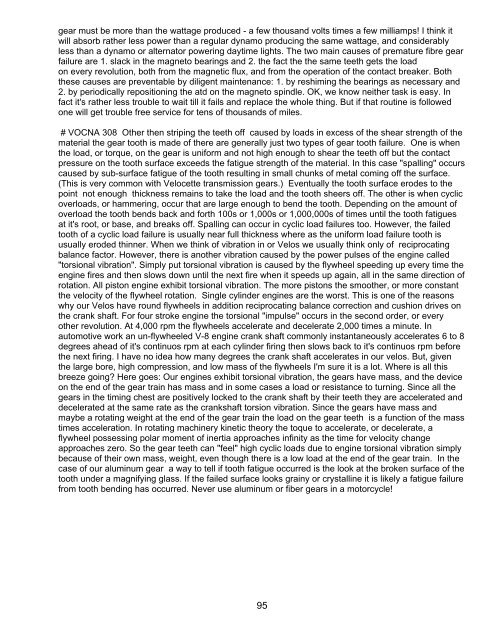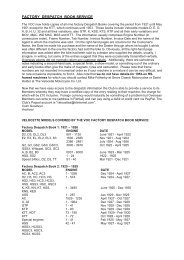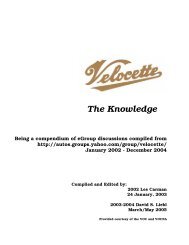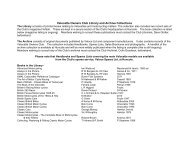The Knowledge - Velocette Owners Club
The Knowledge - Velocette Owners Club
The Knowledge - Velocette Owners Club
Create successful ePaper yourself
Turn your PDF publications into a flip-book with our unique Google optimized e-Paper software.
gear must be more than the wattage produced - a few thousand volts times a few milliamps! I think it<br />
will absorb rather less power than a regular dynamo producing the same wattage, and considerably<br />
less than a dynamo or alternator powering daytime lights. <strong>The</strong> two main causes of premature fibre gear<br />
failure are 1. slack in the magneto bearings and 2. the fact the the same teeth gets the load<br />
on every revolution, both from the magnetic flux, and from the operation of the contact breaker. Both<br />
these causes are preventable by diligent maintenance: 1. by reshiming the bearings as necessary and<br />
2. by periodically repositioning the atd on the magneto spindle. OK, we know neither task is easy. In<br />
fact it's rather less trouble to wait till it fails and replace the whole thing. But if that routine is followed<br />
one will get trouble free service for tens of thousands of miles.<br />
# VOCNA 308 Other then striping the teeth off caused by loads in excess of the shear strength of the<br />
material the gear tooth is made of there are generally just two types of gear tooth failure. One is when<br />
the load, or torque, on the gear is uniform and not high enough to shear the teeth off but the contact<br />
pressure on the tooth surface exceeds the fatigue strength of the material. In this case "spalling" occurs<br />
caused by sub-surface fatigue of the tooth resulting in small chunks of metal coming off the surface.<br />
(This is very common with <strong>Velocette</strong> transmission gears.) Eventually the tooth surface erodes to the<br />
point not enough thickness remains to take the load and the tooth sheers off. <strong>The</strong> other is when cyclic<br />
overloads, or hammering, occur that are large enough to bend the tooth. Depending on the amount of<br />
overload the tooth bends back and forth 100s or 1,000s or 1,000,000s of times until the tooth fatigues<br />
at it's root, or base, and breaks off. Spalling can occur in cyclic load failures too. However, the failed<br />
tooth of a cyclic load failure is usually near full thickness where as the uniform load failure tooth is<br />
usually eroded thinner. When we think of vibration in or Velos we usually think only of reciprocating<br />
balance factor. However, there is another vibration caused by the power pulses of the engine called<br />
"torsional vibration". Simply put torsional vibration is caused by the flywheel speeding up every time the<br />
engine fires and then slows down until the next fire when it speeds up again, all in the same direction of<br />
rotation. All piston engine exhibit torsional vibration. <strong>The</strong> more pistons the smoother, or more constant<br />
the velocity of the flywheel rotation. Single cylinder engines are the worst. This is one of the reasons<br />
why our Velos have round flywheels in addition reciprocating balance correction and cushion drives on<br />
the crank shaft. For four stroke engine the torsional "impulse" occurs in the second order, or every<br />
other revolution. At 4,000 rpm the flywheels accelerate and decelerate 2,000 times a minute. In<br />
automotive work an un-flywheeled V-8 engine crank shaft commonly instantaneously accelerates 6 to 8<br />
degrees ahead of it's continuos rpm at each cylinder firing then slows back to it's continuos rpm before<br />
the next firing. I have no idea how many degrees the crank shaft accelerates in our velos. But, given<br />
the large bore, high compression, and low mass of the flywheels I'm sure it is a lot. Where is all this<br />
breeze going? Here goes: Our engines exhibit torsional vibration, the gears have mass, and the device<br />
on the end of the gear train has mass and in some cases a load or resistance to turning. Since all the<br />
gears in the timing chest are positively locked to the crank shaft by their teeth they are accelerated and<br />
decelerated at the same rate as the crankshaft torsion vibration. Since the gears have mass and<br />
maybe a rotating weight at the end of the gear train the load on the gear teeth is a function of the mass<br />
times acceleration. In rotating machinery kinetic theory the toque to accelerate, or decelerate, a<br />
flywheel possessing polar moment of inertia approaches infinity as the time for velocity change<br />
approaches zero. So the gear teeth can "feel" high cyclic loads due to engine torsional vibration simply<br />
because of their own mass, weight, even though there is a low load at the end of the gear train. In the<br />
case of our aluminum gear a way to tell if tooth fatigue occurred is the look at the broken surface of the<br />
tooth under a magnifying glass. If the failed surface looks grainy or crystalline it is likely a fatigue failure<br />
from tooth bending has occurred. Never use aluminum or fiber gears in a motorcycle!<br />
95





